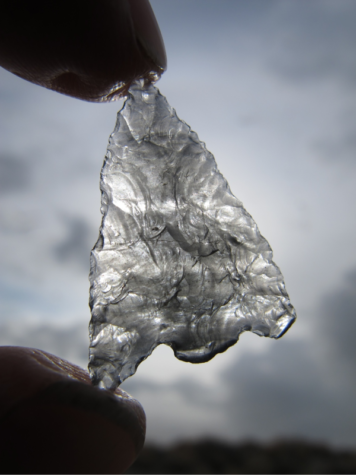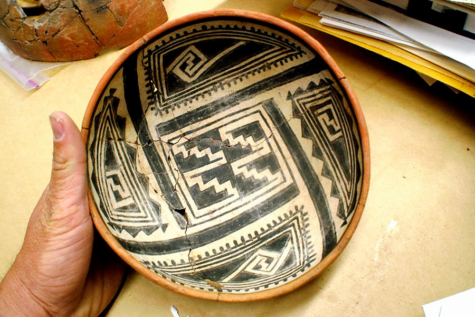 A recent email from a stranger posed a query as to what to do with Native American artifacts in her possession. I’ve never found the answer to be an easy one.
A recent email from a stranger posed a query as to what to do with Native American artifacts in her possession. I’ve never found the answer to be an easy one.
The woman didn’t take much. She called it, “a small box of artifacts, a few really nice perfect arrows and a couple that where truly made by an Indian artist. They were made to look like feathers.”
She wrote that she had collected them when she was a kid on a sandy beach outside a small town in Iowa. Not knowing what to do with them now, she feels as if she has something important in her possession, something centuries or thousands of years old, and they don’t belong to her. “My choices,” she wrote, “keep it in the county, local library, conservation office? Give it to the State, give it to a museum out of the county? I’ve ruled out grandsons and family. Right now I feel like taking it back and dumping it in the lake but the lake has been drained and the county conservation waiting for it to refill?”
I get letters and emails like this because I wrote a book on the subject. People frequently find themselves in an ethical quandary with artifacts they’re holding onto. My book, Finders Keepers, may make the quandary harder.
People have written to me about a piece of a Mayan glyph passed down through a couple generations, a drawer full of arrowheads, a fired Fremont fetish. Some took the artifacts, mostly illegal, off of public land. I’ve noticed that knowing of my work, some people quickly hide their pre-Columbian potsherds or basket of beads and arrowheads when I come to visit. But I don’t mind. We all make choices, and theirs are not the worst. There is no one right thing to do with these things. They get dug up all the time, tombs raided, burials desecrated. If you see a whole vessel in a museum, you can bet it came up with a nest of human bones. Vessels in use were, eventually, broken, pieces scattered. Those buried with the dead stayed together.
While writing on this topic, I brushed up against the illegal artifact trade: pothunters, smugglers, dealers supplying both individuals and institutions. I also ventured into museum compounds, vaults of tens of thousands of whole vessels, Aztec carvings, Choacoan cylinder-jars. In the Peabody ceramics warehouse at Harvard, I was dizzied. The gymnasium-sized building was packed head to toe with delicately kept ancient pottery.

Seeing all these artifacts, private living rooms stuffed with glass cases, public museums stuffed with boxes, it was impossible not to ask the question: What the hell are we doing? It is as if we are gathering all of the past we can get our hands on. Both for the black market and for science, we are claiming this the pinnacle, the only moment in history that truly matters. To us, every age before must bow, every arrowhead becomes our own. I visited an archaeological survey site that a week before had been rich with broken pre-Columbian pottery and flaked stone, and afterword was sterilized, every scrap of artifact and pinflag plucked off the surface and hauled away for storage and later study. I understand this leads to a finer apprehension of the past, a greater understanding of our place. In fact, I celebrate it. I am in love with science. But the cost remains, whether I like it or not. Pieces of land are emptied. Physical memory vanishes from a place.
At Pueblo sites in the Southwest, middens outside of dwellings are considered sacred. The trash is a marker. If you’d come to a cliff dwelling or a ruined pueblo centuries after people moved out, you would know who lived there by the broken, painted pottery on the ground. It is like family papers. To take these pieces, is to disassemble ancestry. What of those who come back in a thousand years, after museums have shuddered or whatever happens next, trying to figure out who lived here? Certainly science thinks in such timeframes.
When the woman wrote me about her feather-like arrowheads a few days ago, I took her query more pointedly than at other times. My house had just been broken into. Someone took their sweet time, leaving cigarettes crushed out. Along with river gear, crampons, a chainsaw, and artwork, the one thing that got me was the contents of a small, 1950s greeting card box. The box had held potsherds, arrowheads, clay pipes, and a couple fetching, polished Desert Archaic pendants. These had been collected by my great-grandfather who lived in southern New Mexico. I wrote about this box in Finders Keepers, deciding I should hold onto it. The box was now my own family heirloom, many different timelines bound together.
When I saw the box on the ground, with a jolly snowman printed on it, and none of the artifacts nearby, a dark feeling sank in my stomach. I was supposed to keep these. I was the caretaker. They passed to my dad and then to me. How feeble is our control when these artifacts have outlived us a thousand times already.
I’m sort of a nihilist. Or maybe it’s just Zen. I’ve learned to walk away with a sort of shrug. Easy come, easy go. The world is so rich that these artifacts disappear and nothing is truly lessened. Yet it pains me somewhere even deeper. What a mess we make.
I answered the woman’s question of what to do with her beautiful arrowheads, saying that museums don’t want more random, ancient mementos to take care of, artifacts with almost no provenance, next to no scientific value. I wrote, “I’d either keep them and see what happens or walk them back out there and scatter them across the ground, letting the lake refill and wash them back to the beach for some little girl to pick up centuries from now.”
Photos by the author
“…scatter them across the ground, letting the lake refill and wash them back to the beach for some little girl to pick up centuries from now.”
I love this advice. I know it’s going to sound trivial, but I hate carrying loose change. So I drop it along our street in various places. (We live near an elementary school.) I hope to turn what I think of as a minor annoyance into a gleaming treasure for some little kid.
We get questions like this at the Anasazi Heritage Center, where we currently store millions of artifacts in the basement where they can be viewed on a special tour and are sometimes displayed or used in larger displays. At the desk, I will generally ask the person to bring in what they have and discuss it with one of the archaeology people.
Having retired a few years ago from the Iowa park system I have had the great fortune to accept responsibility for my artifact collecting. I have kept very little as the “finding in place” was it’s reward. The half-full five gallon bucket of rocks have been my recapitulation of the past and the course of my life since. Returning each piece to its place has produced a pleasure beyond belief. I recommend it as the weight of returning the rocks raises the earth up to cradle me.